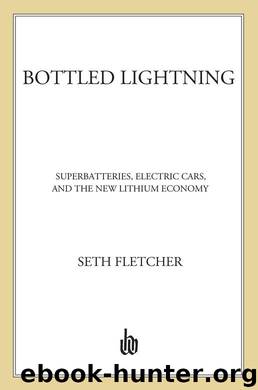Bottled Lightning by Seth Fletcher

Author:Seth Fletcher [Fletcher, Seth]
Language: eng
Format: epub
ISBN: 9781429922913
Publisher: Farrar, Straus and Giroux
Published: 2011-05-10T00:00:00+00:00
8
THE STIMULUS
As the world’s automakers began to cautiously embrace the lithium-ion-powered electrified car, the battery boom began. In 2008 and 2009, think tanks and industry groups issued forecast after forecast assessing the electric car’s chances this time around, and, of course, their conclusions differed wildly, ranging from profoundly pessimistic to delusionally optimistic. But in the battery business everyone knew that even a small electric-car market would be a tremendous opportunity. Even early-adopter volumes of lithium-ion-powered cars of any kind—plug-in hybrids that run on gas after ten or twenty or forty miles, pure EVs, next-generation variations on the basic Prius format—would require a staggeringly large number of batteries. Charles Gassenheimer, the CEO of Ener1, parent company of the American lithium-ion manufacturer Enerdel, liked to say that one hundred thousand electrified cars a year—just twice the number of Leafs Nissan will build for 2011—would “soak up the entire cell capacity that exists in the world today for the cells you have in your laptop computer.”
Advanced-battery start-ups were popping up like mushrooms after a spring rain. Even large automotive suppliers with a steady stream of business in other areas wanted in. Johnson Controls, for instance, an automotive supplier and manufacturing conglomerate with three hundred thousand employees worldwide, decided it needed to enter this new market, and so it sought out a partnership with the French battery company Saft. The Canadian auto supplier Magna began marketing itself as an electric-car-battery packager. Dow Chemical got into the field by forming a joint venture with Kokam, a Korean battery company.
Soon the word “battery” was no longer exclusively associated with the Energizer Bunny and the TV remote. Batteries became a segment of the clean-tech boom, with all the dewy and righteous credibility of thin-film solar and offshore windmills. If anything, the battery industry carried an additional dose of sexiness because of its attachment to futuristic cars like the Tesla Roadster.
National, state, and municipal governments around the world became interested in electrification. Politicians from Israel to Oregon shook hands with executives from the Renault-Nissan alliance, joining in an effort to build charging stations and other EV infrastructure. Austin and Indianapolis began competing with Detroit to become advanced-battery hubs, players in the next big technological thing. Better Place, a battery-swapping and EV-infrastructure company founded by the Silicon Valley entrepreneur Shai Agassi, was circling the globe negotiating electric-car infrastructure deals.
American businessmen and politicians learned to work the battery issue with a simple, persuasive line: “We’re going to end up replacing foreign oil with foreign batteries!” The American auto industry had been kneecapped by the global recession and its own structural imbalances and mismanagement; the lean Detroit that it would take to survive could never make up for all the jobs that had been lost by building cars alone, and so the notion of building a sister enterprise—an American advanced-battery industry—was irresistible. Detroit wouldn’t just build cars; it would build a new breed of car and the batteries that go into those cars, along with the solar panels and windmills that will charge those batteries.
Download
This site does not store any files on its server. We only index and link to content provided by other sites. Please contact the content providers to delete copyright contents if any and email us, we'll remove relevant links or contents immediately.
Whiskies Galore by Ian Buxton(41937)
Introduction to Aircraft Design (Cambridge Aerospace Series) by John P. Fielding(33092)
Small Unmanned Fixed-wing Aircraft Design by Andrew J. Keane Andras Sobester James P. Scanlan & András Sóbester & James P. Scanlan(32763)
Craft Beer for the Homebrewer by Michael Agnew(18196)
Turbulence by E. J. Noyes(7977)
The Complete Stick Figure Physics Tutorials by Allen Sarah(7336)
Kaplan MCAT General Chemistry Review by Kaplan(6899)
The Thirst by Nesbo Jo(6877)
Bad Blood by John Carreyrou(6581)
Modelling of Convective Heat and Mass Transfer in Rotating Flows by Igor V. Shevchuk(6406)
Learning SQL by Alan Beaulieu(6237)
Weapons of Math Destruction by Cathy O'Neil(6214)
Man-made Catastrophes and Risk Information Concealment by Dmitry Chernov & Didier Sornette(5956)
Digital Minimalism by Cal Newport;(5704)
Life 3.0: Being Human in the Age of Artificial Intelligence by Tegmark Max(5513)
iGen by Jean M. Twenge(5384)
Secrets of Antigravity Propulsion: Tesla, UFOs, and Classified Aerospace Technology by Ph.D. Paul A. Laviolette(5332)
Design of Trajectory Optimization Approach for Space Maneuver Vehicle Skip Entry Problems by Runqi Chai & Al Savvaris & Antonios Tsourdos & Senchun Chai(5037)
Pale Blue Dot by Carl Sagan(4953)
